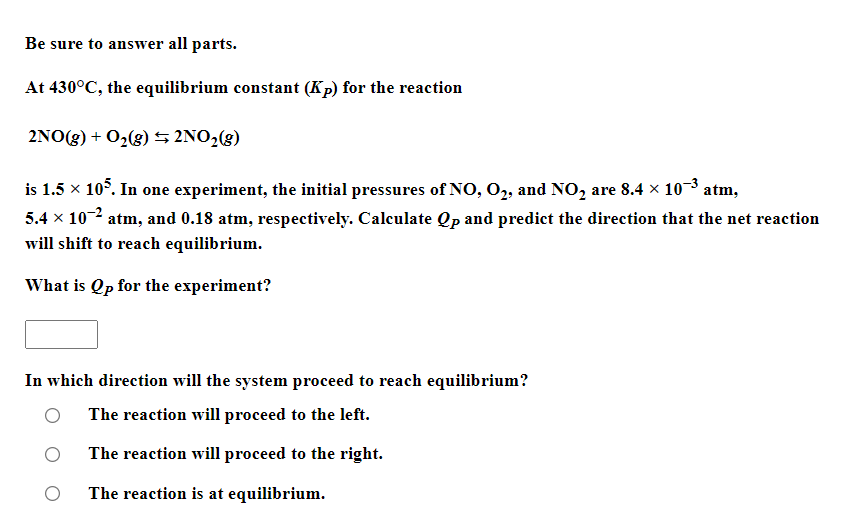Be sure to answer all parts. At 430°C, the equilibrium constant (Kp) for the reaction 2NO(g) + O2(8) 5 2NO2(g) is 1.5 x 10°. In one experiment, the initial pressures of NO, O2, and NO, are 8.4 x 103 atm, 5.4 x 102 atm, and 0.18 atm, respectively. Calculate Qp and predict the direction that the net reaction will shift to reach equilibrium. What is Qp for the experiment? In which direction will the system proceed to reach equilibrium? The reaction will proceed to the left. The reaction will proceed to the right. The reaction is at equilibrium.
Be sure to answer all parts. At 430°C, the equilibrium constant (Kp) for the reaction 2NO(g) + O2(8) 5 2NO2(g) is 1.5 x 10°. In one experiment, the initial pressures of NO, O2, and NO, are 8.4 x 103 atm, 5.4 x 102 atm, and 0.18 atm, respectively. Calculate Qp and predict the direction that the net reaction will shift to reach equilibrium. What is Qp for the experiment? In which direction will the system proceed to reach equilibrium? The reaction will proceed to the left. The reaction will proceed to the right. The reaction is at equilibrium.
Chemistry & Chemical Reactivity
9th Edition
ISBN:9781133949640
Author:John C. Kotz, Paul M. Treichel, John Townsend, David Treichel
Publisher:John C. Kotz, Paul M. Treichel, John Townsend, David Treichel
Chapter15: Principles Of Chemical Reactivity: Equilibria
Section: Chapter Questions
Problem 38GQ: At 2300 K the equilibrium constant for the formation of NO(g) is 1.7 103. N2(g) + O2(g) 2 NO(g)...
Related questions
Question

Transcribed Image Text:Be sure to answer all parts.
At 430°C, the equilibrium constant (Kp) for the reaction
2NO(g) + O2(8) 5 2NO2(g)
is 1.5 x 10°. In one experiment, the initial pressures of NO, O2, and NO, are 8.4 x 103 atm,
5.4 x 102 atm, and 0.18 atm, respectively. Calculate Qp and predict the direction that the net reaction
will shift to reach equilibrium.
What is Qp for the experiment?
In which direction will the system proceed to reach equilibrium?
The reaction will proceed to the left.
The reaction will proceed to the right.
The reaction is at equilibrium.
Expert Solution
This question has been solved!
Explore an expertly crafted, step-by-step solution for a thorough understanding of key concepts.
Step by step
Solved in 2 steps with 2 images

Knowledge Booster
Learn more about
Need a deep-dive on the concept behind this application? Look no further. Learn more about this topic, chemistry and related others by exploring similar questions and additional content below.Recommended textbooks for you

Chemistry & Chemical Reactivity
Chemistry
ISBN:
9781133949640
Author:
John C. Kotz, Paul M. Treichel, John Townsend, David Treichel
Publisher:
Cengage Learning

Chemistry & Chemical Reactivity
Chemistry
ISBN:
9781337399074
Author:
John C. Kotz, Paul M. Treichel, John Townsend, David Treichel
Publisher:
Cengage Learning

Chemistry: The Molecular Science
Chemistry
ISBN:
9781285199047
Author:
John W. Moore, Conrad L. Stanitski
Publisher:
Cengage Learning

Chemistry & Chemical Reactivity
Chemistry
ISBN:
9781133949640
Author:
John C. Kotz, Paul M. Treichel, John Townsend, David Treichel
Publisher:
Cengage Learning

Chemistry & Chemical Reactivity
Chemistry
ISBN:
9781337399074
Author:
John C. Kotz, Paul M. Treichel, John Townsend, David Treichel
Publisher:
Cengage Learning

Chemistry: The Molecular Science
Chemistry
ISBN:
9781285199047
Author:
John W. Moore, Conrad L. Stanitski
Publisher:
Cengage Learning

Chemistry for Engineering Students
Chemistry
ISBN:
9781337398909
Author:
Lawrence S. Brown, Tom Holme
Publisher:
Cengage Learning

Chemistry: Principles and Practice
Chemistry
ISBN:
9780534420123
Author:
Daniel L. Reger, Scott R. Goode, David W. Ball, Edward Mercer
Publisher:
Cengage Learning

Chemistry by OpenStax (2015-05-04)
Chemistry
ISBN:
9781938168390
Author:
Klaus Theopold, Richard H Langley, Paul Flowers, William R. Robinson, Mark Blaser
Publisher:
OpenStax